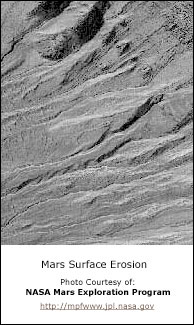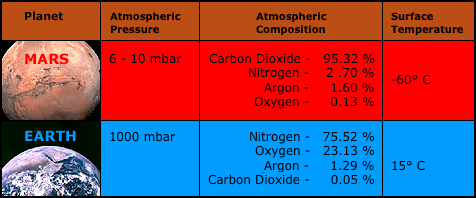Mars, a planet once warm enough to support water, is now a cold and dry wasteland unable to sustain human life. Many scientists believe that through the introduction of carbon dioxide to the atmosphere, the Martian environment can be terraformed into a planet like Earth. Possible methods for introducing carbon dioxide include the spread of green plants and the construction of CFC factories. A lingering question, however, is whether it is ethical to reform an entire ecosystem.
Imagine walking outside your home on a warm summer’s night and feeling a cool breeze hit your face. You walk across your lawn and feel the soft grass bend beneath your feet. Then, you look up at the beautiful full moons?
Introduction
Someday this fantasy could be reality, as it may be possible for humans to inhabit the planet Mars. But, for now, the surface of Mars is a frozen wasteland void of liquid water, a necessary condition for life. Many scientists, however, believe that this has not always been the case. Eroded canals and networks of valleys indicate that Mars’ surface was once warm enough to support running water [1] (see Fig. 1). For unknown reasons, the planet cooled down rapidly, freezing the majority of the water into the ground [2]. Because the surface of Mars did not contain enough of the minerals that cause volcanic activity, the water was unable to be recycled into the atmosphere. Over the years, however, bursts of heat have allowed some water to escape into the atmosphere in the form of clouds and fog [2]. This has led to the Mars of today—a lifeless planet with no accessible water.
But because Mars once had a warm environment suitable for life, some scientists believe that such an environment can be recreated. Most specialists believe that it is possible, but not without much effort. Researchers such as planetary scientist Chris McKay have been developing ideas to terraform Mars; that is, modify the conditions of Mars so that it becomes more like Earth [1]. In order to understand how this might be possible, it is important to first look at what key conditions make Mars uninhabitable in the first place.
What needs to be changed?
Mars is the most suitable planet in our solar system for human habitation because it bears some semblance to Earth — a similar rotation rate and adequate surface gravity — that will make it easier for humans to adjust. A similar rate of rotation will make the days feel about the same length as Earth days, and adequate surface gravity will allow our muscles to function properly [3]. That being said, Mars possesses many physical characteristics that are not conducive to human life. Although an incredible number of nuanced changes would have to be made to make Mars inhabitable, the following will describe the two main areas that would need to be changed: atmosphere and surface temperature.
Atmosphere
The current Martian atmosphere is far too hostile to support the human body. One problem is that the atmospheric pressure on Mars ranges from six to ten millibar, which is less than one percent of Earth’s atmospheric pressure at sea level: 1000 millibar [4]. The importance of pressure stems from the scientific certainty that higher pressure states will move into lower pressure states. If the atmospheric pressure is lower than a human’s lung pressure, then that person’s lungs will burst. The average human lung pressure is around 250 millibar; Mars’ atmospheric pressure will need to be raised at least to an equivalent amount [3].
A second problem is that the elemental composition of the Martian atmosphere little resembles that of Earth. The majority (95.32%) of the Martian atmosphere is carbon dioxide, and oxygen only constitutes a mere 0.13% [5]. On Earth, the two main elements are nitrogen (75%) and oxygen (23%). Carbon dioxide makes up only .05% of the Earth’s atmosphere (“Earth”). Humans respiratory functions require that oxygen make up at least 13% of the atmosphere, and that no more than 10% of the atmosphere be carbon dioxide [3]. The abundance of carbon dioxide found on Mars is not necessarily an obstacle, however. Although carbon dioxide is not healthy for the human respiratory system, plants and other photosynthetic organisms readily utilize it. Therefore, the large amount of carbon dioxide could be used by those plants during photosynthesis to convert the atmosphere into the more valuable element, oxygen. This concept of using plants to change the atmospheric composition is one of the cornerstones of current theories for terraforming Mars.
Surface temperature
The average surface temperature on Mars is -60°C, which is extremely cold compared to the 15°C average temperature on Earth [3]. Since the human body is made up largely of water, humans cannot withstand temperatures much below water’s freezing point of 0°C. In addition, humans need liquid water to keep hydrated. Since all the water on Mars is frozen, the average surface temperature would need to be altered to create a ready supply of water. Thus, the Martian temperature should be raised above the freezing point of 0°C but no higher than the boiling point of 100°C [4]. To have livable conditions on Mars, then, the surface temperature would have to be raised at least 60°C, to a temperature of 0°C. Since humans are accustomed to the conditions on Earth, a 75°C raise (to Earth’s surface temperature of 15°C) would desirable for comfortable living conditions.
What methods could be used?
The general consensus among experts is that the use of greenhouse gases would be the most effective way to both change the atmosphere and raise the surface temperature. The main benefit of using greenhouse gases is that carbon dioxide is a greenhouse gas. As already mentioned, Mars has an abundance of carbon dioxide in the atmosphere, as well as a large supply of CO2 in its polar ice caps and regolith, which contains about 300 millibar worth of CO2 [3]. Greenhouse gases trap heat radiated by the planet, causing the surface temperature to rise. By supplying an additional source of greenhouse gas, a snowball effect will occur.
The greenhouse gas snowball effect is as follows:
- An additional source of CO2 would be added to the Martian atmosphere, causing the planet’s temperature to rise.
- An increase in surface temperature would cause partial melting of the polar ice caps and regolith.
- Since the polar ice caps and regolith contain CO2, more carbon dioxide would be released into the atmosphere, thereby returning to step one [3].
Through this process, the surface temperature can be increased while the extra carbon dioxide in the air thickens the atmosphere. Liquid water would also be produced by the melting ice caps. The question remains as to how the initial source of carbon dioxide will be added to the atmosphere. One possible option is to begin the heating process and let the melting ice caps provide the initial source. Another option would be to manually place the CO2 into the atmosphere. Green plants could be used for heating and CFC factories could be used to supply the initial source.
Green plants
The use of plants was first suggested by planetary scientist Chris McKay in the 1980s [1]. One benefit of this suggestion is that the organisms would self-propagate. The dark color of plants spread over the ice caps would capture and retain solar energy and heat the ice below it. This catalyst would discharge the required carbon dioxide into the air and begin the snowball effect. The implementation of this method, however, could take anywhere between 100 to 10,000 years [1]. It has recently been hypothesized that genetically engineered microbes could be used instead of plants, with the added benefit that microbes could be engineered to better endure the Martian landscape. Both the plants and the microbes also would help to convert the CO2 into oxygen. Hence, the use of this method would solve all environmental needs mentioned in the previous section.
One problem with the plant concept, however, is that the Martian soil would be arid and unable to sustain the seedlings in the initial stages of terraforming. To solve this problem, scientists E.Imre Friedmann and Roseli Ocampo-Freidmann discovered that inoculating the soil with a more primitive organism, a cyanobacterium named Chroococcidiopsis, causes the soil to absorb and hold water more efficiently: “only periodic wetting, perhaps a few times a year, would be needed to provide the conditions for hypolithic microbial growth” [6]. In other words, the plants growing from soil containing this cyanobacterium would not need to be watered nearly as often. The cyanobacterium is similar to the primitive organisms found on early Earth and can tolerate a wide range of environmental extremes [5]. Thus, the cyanobacterium would have no problem thriving in present Martian conditions, and could be placed in the soil before any of the other terraforming measures took place.
CFC factories
Sidebar
This method includes building many CFC factories, which produce powerful artificial greenhouse gases such as halocarbons. Building these factories would require raw materials and man-power that would be brought from earth. After the factories were up and running, they could produce the needed supply of greenhouse gases to start the effect. Similar to the spreading of plants, however, it would take quite a bit of time to get the factories built. Even after construction is complete, it could take up to 100,000 years before Mars was ready for habitation [1]. Moreover, this process does not supply any oxygen to the atmosphere in the way that the plants would.
In consideration of the possible methods, the best choice seems to be the combinational use of microbes and the cyanobacterium. One trip could be made to inoculate the soil with the cyanobacterium and to cover the ice caps with the genetically engineered microbes. This method would be the cheapest, because it would not involve the added cost of the raw materials and man-power necessary for the CFC factories. The combination also would ultimately allow for the fastest terraforming, as the bacteria would allow the Martian soil to be ready for planting as soon as water is found on the surface. What is the next step?
Ethical Considerations
Before everyone starts jumping on the next shuttle flight to Mars, there are ethical issues to consider in regards to terraforming. The most fundamental question asks “Why do we (as humans) have the right to take over and change an entire planet?” No simple answer exists to this query. Some may believe that changing a planet would be playing God. On the contrary, others contend that it is essential to the survival of the human race. Moreover, one must reflect on the possibility of life already existing on Mars; the act of terraforming would surely eradicate all life that was already there. As the author of an article in Space Policy, Mark Lupisella proclaimed, “Could we forgive ourselves if we caused the extinction of the first extraterrestrial species we came into contact with?” [1]. Thus, before any actual measures are taken to terraform Mars, scientists should more thoroughly examine the planet and fully understand the environment found on its surface. One should not destroy a current ecosystem based only on speculations that no life exists there. Also, a comprehensive knowledge of the planet is necessary to judge what the best methods are to terraform.




